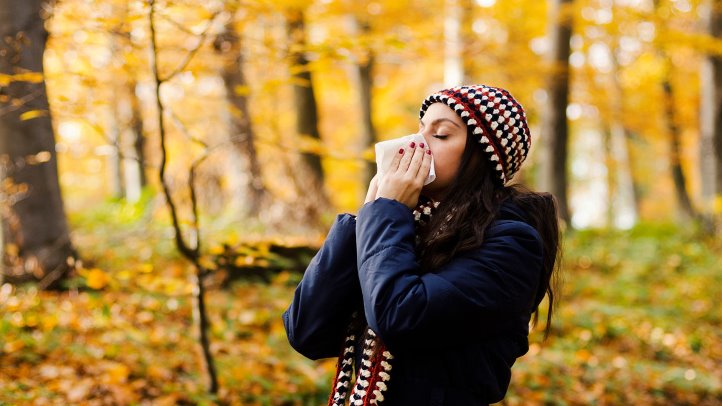You know the feeling – scratchy throat, dry and itchy eyes, runny nose. Your allergies are acting up again, and boy, is it uncomfortable. To make matters worse, so-called “seasonal” allergies rarely have the decency to stick to just one season of the year. You can still be snuffling and coughing as summer comes to a close due to the ability of certain allergens to take up residence in the hard-to-reach corners of your home.
But with proper preparation and maintenance, you can reduce your fall allergy symptoms significantly. We’ll break down some of the most common allergy triggers and discuss strategies to keep them at bay. You can’t filter the whole world, but you can make your home a haven of comfort.
Common Fall Allergens & Ways to Fight Them
These pesky but very common substances will stuff you up, even when the air gets chilly and leaves start to fall. In fact, these allergens can circulate about the house via air ducts and hang around all winter long.
Ragweed
Ragweed is a yellow flowering plant that first blooms in August but keeps on pumping out spores until the plant is killed by the first hard frost. Just one plant can produce in excess of one billion grains of pollen each season! Ragweed is also one of the most common irritants for allergy sufferers, as up to 75% of people who have springtime allergies are also bothered by ragweed in the fall.
Eradicating Ragweed
Beyond taking your doctor-prescribed or over-the-counter allergy medication, ragweed sufferers tend to feel a lot better when they have regular air duct cleaning in their homes. This professional service scrapes all the accumulated dust and debris from your HVAC system, including ragweed pollen, so that it can’t recirculate throughout the home.
Mold & Mildew
Mold and mildew thrive in damp conditions, and can be especially problematic in the autumn when leaves fall to the ground and harbor moisture. These allergens can also get a foothold indoors in spaces that are consistently humid, such as basements, bathrooms, and around improperly sealed doors. Freezing temps can temporarily halt mold growth, but colonies easily reactivate when it warms up.
Busting Mold & Mildew for Good
Sometimes bothersome mold and mildew can be managed simply by controlling the humidity level in your home. Running a dehumidifier in the basement, for example, makes a huge difference. You can also commit to wiping away moisture as it accumulates in spaces like the bathroom after a shower or metal doorframes after a rain. You’ll also need to remove any visible mold with a cleaning agent such as vinegar or bleach.
However, you might not be able to see all of the mold that exists. For that reason, consider engaging a commercial mold removal company to ensure that your entire home is free of mold and mildew. Once that is done, it becomes a lot easier to stay on top of the problem yourself.
Dust Mites
Dust mites live indoors and are impossible to totally eradicate. Still, you’ll feel a lot more comfortable if you take steps to reduce their numbers, especially when conditions in your home tend toward the dry side. Dust mite allergies often flare when your central heat is turned on for the first time each season, and these little buggers are notorious for circulating through a home via the HVAC system.
Dealing with Dust Mites
It stands to reason that making sure to regularly clean all surfaces in your home can reduce the population of dust mites living with you. That means dusting and then following up with a thorough vacuuming of carpets and upholstery.
Again, if it has been a few years since you had your HVAC serviced, an air duct cleaning can also help prevent dust mites from continuously circulating. If you are especially sensitive to dust mites, try wearing a mask over your nose and mouth when you clean or move furniture or stored boxes around.
Pet Dander & Fur
Many a pet owner would say that the joy they receive from their furry friend is worth a little bit of sniffling. People who suffer from animal allergies can react to the fur, dander (shed skin cells), saliva, or even urine of their pets.
Allergies triggered by furry animals represent another common crossover from plant-based allergies, with around 40% of seasonal allergy sufferers also being bothered by pets. And pet allergies, of course, know no season.
Ditch the Dander, Not Your Pets
When you are allergic to an animal that lives in your home, you probably need to take some kind of allergy medication on a daily basis. Regular cleaning is also critical to remove hair and dander that floats in the air and settles on surfaces. You may want to keep one or two rooms of the house pet-free and try to keep your furry friend from getting up on the furniture.
If you haven’t adopted your pet yet and are concerned about allergies, you can target particular breeds or types of animal that are less likely to cause issues. Cats are roughly twice as likely as dogs to trigger allergies in humans, but many dogs – especially Saint Bernards and bulldogs – can also be problematic. On the other hand, dogs that don’t shed are more likely to be hypoallergenic. Rodents like guinea pigs, hamsters, mice, and rats do shed but might not cause an allergic reaction, even if you are allergic to cats or dogs.
The Last Word
Allergens are omnipresent in our environment and contrary to popular belief, can actually spike when the growing season ends and summer gives way to fall. A lot can be done to minimize the suffering within your own home, but it’s a constant battle. Professional services like air duct cleaning and commercial mold removal can help you keep ahead of the onslaught. Regular dusting and attention to maintaining a healthy humidity level (between 35-50%) are also great strategies.
And finally, take comfort in this – when you put these strategies into effect and heed advice from your doctor, you could experience your most comfortable allergy season yet.
To read more on topics like this, check out the health category.




